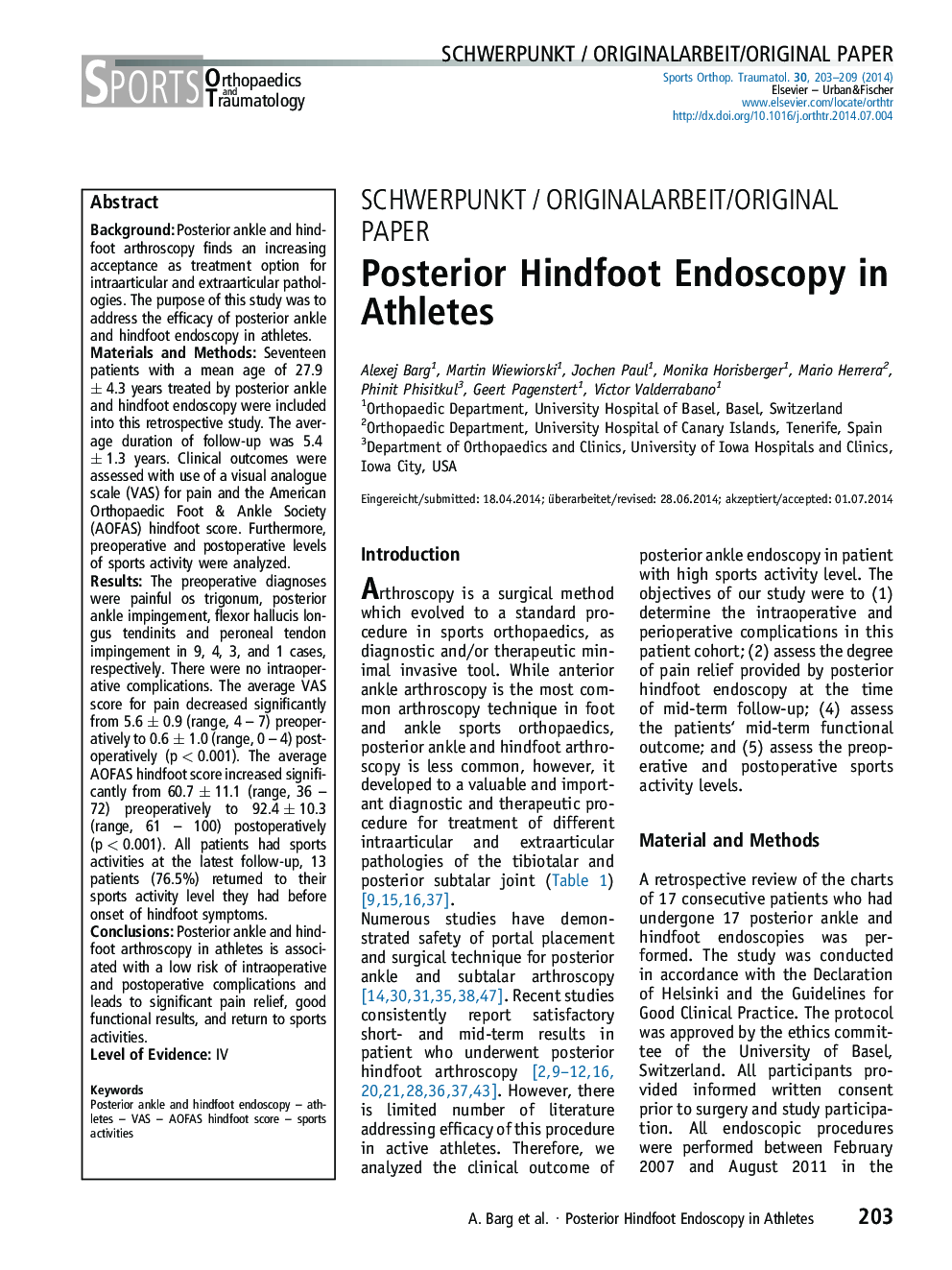| Article ID | Journal | Published Year | Pages | File Type |
|---|---|---|---|---|
| 2740288 | Sports Orthopaedics and Traumatology | 2014 | 7 Pages |
ZusammenfassungHintergrundZiel dieser Arbeit war es, die mittelfristigen Ergebnisse der posterioren Rückfußendoskopie bei Sportlern zu präsentieren.Material und MethodenInsgesamt wurden 17 Patienten mit einem mittleren Alter von 27,9 ± 4,3 Jahren in diese retrospektive Studie eingeschlossen. Die mittlere Nachuntersuchungszeit betrug 5,4 ± 1,3 Jahre. Klinische Ergebnisse wurden untersucht anhand einer visuellen Punkteskala (VAS) sowie eines AOFAS (American Orthopaedic Foot & Ankle Society)-Hindfoot-Score. Außerdem analysierten wir die präoperativen und die postoperativen sportlichen Aktivitäten.ErgebnisseZu den präoperativen Diagnosen gehörten schmerzhaftes Os trigonum (n = 9), Sehnenentzündung des M. flexor hallucis longus (n = 4), posteriores Rückfußimpingement (n = 3) und Impingement der Peronealsehnen (n = 1). Das durchschnittliche Schmerzniveau verringerte sich von präoperativ VAS 5,6 ± 1,7 zum 0,6 ± 1,0 postoperativ (p < 0,001). Der AOFAS-Hindfoot-Score verbesserte sich von präoperativ 60,7 ± 11,1 zum 92,4 ± 10,3 postoperativ (p < 0,001). Alle Patienten waren zum Zeitpunkt der letzten Nachuntersuchung sportlich aktiv, 13 Patienten (76,5%) erreichten das gleiche Niveau der sportlichen Aktivitäten wie vor den Rückfußbeschwerden.SchlussfolgerungenDie posteriore Rückfußendoskopie bei Sportlern führt zu einer deutlichen Schmerzlinderung, funktionellen Verbesserung und Wiederaufnahme der sportlichen Aktivitäten.EvidenzebeneLevel IV
BackgroundPosterior ankle and hindfoot arthroscopy finds an increasing acceptance as treatment option for intraarticular and extraarticular pathologies. The purpose of this study was to address the efficacy of posterior ankle and hindfoot endoscopy in athletes.Materials and MethodsSeventeen patients with a mean age of 27.9 ± 4.3 years treated by posterior ankle and hindfoot endoscopy were included into this retrospective study. The average duration of follow-up was 5.4 ± 1.3 years. Clinical outcomes were assessed with use of a visual analogue scale (VAS) for pain and the American Orthopaedic Foot & Ankle Society (AOFAS) hindfoot score. Furthermore, preoperative and postoperative levels of sports activity were analyzed.ResultsThe preoperative diagnoses were painful os trigonum, posterior ankle impingement, flexor hallucis longus tendinits and peroneal tendon impingement in 9, 4, 3, and 1 cases, respectively. There were no intraoperative complications. The average VAS score for pain decreased significantly from 5.6 ± 0.9 (range, 4 – 7) preoperatively to 0.6 ± 1.0 (range, 0 – 4) postoperatively (p < 0.001). The average AOFAS hindfoot score increased significantly from 60.7 ± 11.1 (range, 36 – 72) preoperatively to 92.4 ± 10.3 (range, 61 – 100) postoperatively (p < 0.001). All patients had sports activities at the latest follow-up, 13 patients (76.5%) returned to their sports activity level they had before onset of hindfoot symptoms.ConclusionsPosterior ankle and hindfoot arthroscopy in athletes is associated with a low risk of intraoperative and postoperative complications and leads to significant pain relief, good functional results, and return to sports activities.Level of EvidenceIV
